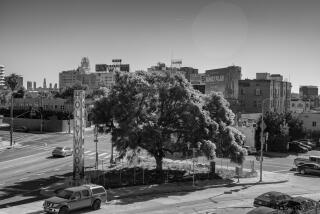Tribute to presidents takes root
- Share via
ST. LOUIS — The slender little beech tree planted recently on property near the Missouri Botanical Garden looked pretty much like any other specimen. But it was special -- scientifically and historically.
The clump beech, cloned from one at President Theodore Roosevelt’s Sagamore Hill home on New York’s Long Island, joined an ash tree cloned from George Washington’s Mount Vernon estate. Plans are to add genetic replica trees from properties owned by Thomas Jefferson and Abraham Lincoln.
Ultimately, the small grove will become a tree tribute to the four presidents represented on Mt. Rushmore.
This unique nod to history and horticulture will grow on the grounds of the National Garden Clubs Inc., a 230,000-member nonprofit that promotes a love of gardening in the United States and overseas.
The organization’s headquarters is on six acres next to the Missouri Botanical Garden.
Creating the tribute has been a team effort.
The trees are being presented to the garden clubs’ headquarters by the Michigan-based Champion Tree Project and Connecticut-based Bartlett Tree Experts, which have been working to preserve the legacy of old-growth trees from presidential properties.
“We really look at this collection as a gift to America, to all of our children and grandchildren and generations to come,” said David Milarch, co-founder of the Champion Tree Project, based in Copemish, Mich.
He and son Jared created the nonprofit in 1996 to preserve the genetics of “the last great trees of America.” The organization has cloned about 100 trees, many of them virgin, old-growth trees, including some of the oldest and largest in the nation. The organization also has an interest in trees with ties to history, such as those planted by presidents or growing on their homesteads.
By cloning trees, rather than just planting a tree’s offspring, the tree’s genetic material can be replicated. When the old-growth genetic copies are planted in reforestation projects, they can cross-pollinate with other trees, ultimately creating stronger and healthier forests, Milarch said. It also teaches people about the environment and history.
Visitors to both the nation’s Capitol and the St. Louis site can view ash trees cloned from Mount Vernon.
“There’s a reverence. A lot of people walk up and it’s like they’re going to a cathedral. For some, something clicks in their minds, and they reflect on these men and all they’ve done for their country,” Milarch said.
“I think the idea of a presidential collection of trees is a stunning idea,” said David McMaster of Bartlett Tree Experts, based in Stamford, Conn., that donates labor and equipment to remove branches with buds from treetops to be cloned.
If the original tree dies due to a lightning strike or storm, as has been the case with the ash from Mount Vernon and a different, well-known tree from Roosevelt’s property, the genetic copies can be donated back to the site or viewed elsewhere.
The trees with presidential ties planted on the St. Louis property are a way “to preserve history through trees,” said Fran Mantler, executive director of National Garden Clubs.






